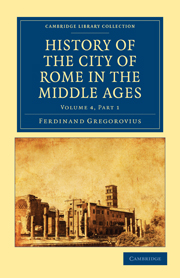CHAPTER IV
Published online by Cambridge University Press: 05 October 2010
Summary
Cadaius comes to Italy, 1062
Before Cadalus advanced against Rome, Hildebrand was untiringly active in gaining adherents and in holding negotiations with Godfrey of Tuscany, with the nobility in Lombardy and with the Normans. Alexander II., weak and dependent, sheltered himself with confidence behind his archdeacon, whom he immediately raised to the office of chancellor. By his side stood Damiani, whose inspired pen he employed in writing pamphlets in the cause of Rome. Cadalus paid no heed to the fiery philippics, in which the hermit implored him to retire from his usurpation, and in which he announced (though he proved himself a false prophet) his death in the space of a year. The Bishop of Parma, previously chancellor of Henry III., a courtier of some intelligence, found no reason for regarding himself as a usurper, but sufficient grounds for bestowing the title on his opponent. His personal qualities were too insignificant to inspire dread in the followers of Hildebrand; but his wealth was princely, and he hoped to open S. Peter's with a golden key, as easily as he had opened the gates of venal Rome. He equipped troops and descended on Italy in the spring of 1062. The imperial party here escorted him with honour from city to city, while Beatrix of Tuscany placed obstacles in his way in vain. He made a halt in Parma, in order to strengthen his army with the vassals of his bishopric, to unite his forces with the rebellious Romans, and then to advance against the city.
- Type
- Chapter
- Information
- History of the City of Rome in the Middle Ages , pp. 132 - 166Publisher: Cambridge University PressPrint publication year: 2010First published in: 1896

